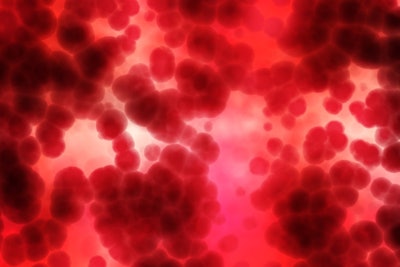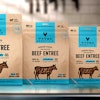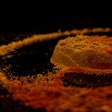
In a recent Ask The Pet Food Pro session, Roger Gerlach, director of global pet food sales at APC, discussed the versatile applications of plasma in pet food formulations. Gerlach highlighted how plasma serves as much more than a simple protein source, offering numerous functional and nutritional benefits across various pet food formats.
Understanding plasma as an ingredient
Plasma differs fundamentally from blood meal and other blood-derived ingredients, noted Gerhlach. "Plasma and blood meal differ in that plasma is a fraction of whole blood, where blood meal is typically made from dried whole blood," he explained. "We collect the whole blood, and then we separate the fractions — the red blood cells then the plasma fraction."
This fractionation process is crucial because plasma retains all the biological health value of the blood. "It's very rich in amino acids; it's high in protein," said Gerlach, noting plasma provides a concentrated protein source ranging from 71% to 78%, depending on the specific product.
Red blood cells, by contrast, serve primarily as a higher protein additive and are sometimes used for color enhancement. "In the pet food world, red blood cells are sometimes used for color, because we can darken kibble and wet food, change the color a little bit," Gerlach noted, adding that this natural coloring option is becoming increasingly relevant as the FDA is now scrutinizing artificial colors in both human foods and pet foods.
Interestingly, plasma's use extends beyond pet food into human applications, which helps consumers embrace the ingredient. "Medical plasma is big on the human side," Gerlach said, noting that APC has a sister company that focuses on the use of medical plasma. This crossover helps build consumer trust because they it it as a human health item and understand it can translate to a pet product.
Functional nutrition applications
APC has invested heavily in research, with Gerlach noting the company has over 600 peer-reviewed papers and journal articles on the use of plasma and use of plasma and gut health in several different species.
Recent completed studies include research with the University of Illinois examining microbiome and gut health in dogs. "We saw improved digestibility, saw improved fecal scores, improved utilization short-chain fatty acids and improved serum metabolites, just to name a few," Gerlach reported.
The health benefits aren't limited to any single life stage. "It's not necessarily isolated to just puppies," he explained. "There are benefits that we see in all life cycles and life stages of the animals. While gut health support proves particularly valuable for puppies, mobility research shows promise for senior dogs."
Looking forward, APC is exploring plasma applications beyond current uses. "We're looking at skin and coat as a project," he said. "We know in other species, we've had great results in skin and coat. We've got some great work in the horse world on that, but we want to translate that to the pet world. APC is also investigating plasma's potential role in weight control for both dogs and cats."
Processing and formulation advantages
Gerlach described plasma's reputation in wet pet food. "Plasma really first gained its notoriety, if you will, for use in wet pet foods," he said. "Plasma is considered the gold standard in binding, emulsification, water holding capabilities, and is very often used in wet diets for those product features."
The ingredient performs effectively across formats. In chunks and gravy products, plasma does a great job to hold the food together while it's integrating, so it doesn't dissipate in the package. "When the customer opens that pouch and pours it out, they actually see the chunks separating and separate from the gravy," he said.
The fresh pet food category has particularly benefited from plasma's functional properties. "We've just worked with some different companies that are launching products very soon on the commercial side, with plasma in fresh diets to hold that water holding capacity," Gerlach noted, explaining that "when the customer opens that fresh product, it comes out as crumbles and looks like meat and so forth. Typically, the consumer doesn't want to see free water in that."
In dry kibble formulations, plasma addresses a key challenge in high-meat diets. "The more meat you add to a product, the more water it brings," Gerlach explained. Research at the Wenger laboratory showed that when plasma is added to a kibble, meat levels can be taken higher because of plasma's water holding ability. "Plasma helps get the product through the extruder," he said. "We can make good kibbles with a much higher meat content when you use plasma."
The durability benefits also matter financially. "If you're a manufacturer, I have less fines," he explained. "That's money to me if I have fines hitting the floor. Even as a consumer, when a product is packaged, palletized, wrapped, put on a truck, shipped to a store, shelved, you know, moved around — as a consumer, I still get less fines at the bottom of the bag when I take it home and open that bag."
Regarding binding efficiency, plasma offers impressive replacement ratios. "It's as much as a one-to-four replacement," Gerlach said. "One part plasma takes away four parts of wheat gluten. Even though wheat gluten tends to be a very inexpensive, cheap ingredient, you know, you can still look at even cost savings using the plasma when you're replacing that much wheat gluten versus plasma."
Palatability without being a palatant
Regarding palatability, Gerlach was emphatic: "It's extremely palatable for dogs and especially cats. Cats absolutely love it -- cats tear into the bags for it."
While plasma significantly enhances palatability, Gerlach was careful to clarify its classification. "We don't consider it a palatant, if you will," he explained. "It is a very palatable ingredient. In many cases, it can help manufacturers reduce the use of palatants. However, I'm not suggesting that anybody run right out there and start using plasma and take their palatants out."
Clean label and sustainability
"Plasma is a natural ingredient," said Gerlach. "We offer natural statements that we meet AAFCO's natural definitions. We've even had some companies that have clean label products feature plasma in the products as a clean label ingredient."
The sustainability story behind plasma is compelling. "Our company's business model over the past four years has been to take what was once a waste stream product and make a functional value-added product out of it," Gerlach explained. "Typically, blood was a very challenging product; it was just getting disposed into waste streams, dumped anywhere, buried in landfills even."
Product versatility and future applications
Gerlach described plasma as the company's "Swiss Army knife of ingredients -- it can do many, many things." When asked about format limitations, he responded: "We haven't found limitations yet on pet food form.
"We really haven't found that limit or that barrier yet," he concluded. "We keep doing different research and work with different customers, joint research with customers, and we continue to be excited about the results that we see."















